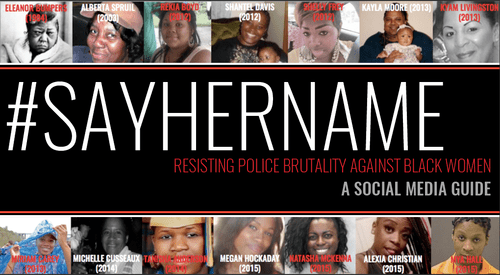 | ||
Nikki skies say her name all def poetry x da poetry lounge
#SayHerName is a social movement that seeks to raise awareness for black female victims of police brutality and anti-Black violence in the United States. #SayHerName aims to change the public perception that victims of police brutality and anti-Black violence are predominantly male by highlighting the gender-specific ways in which black women, particularly black queer women and black transgender women, are disproportionately affected by fatal acts of racial injustice. In an effort to create a large social media presence alongside existing racial justice campaigns, such as #BlackLivesMatter and #BlackGirlsMatter, the African American Policy Forum (AAPF) coined the hashtag #SayHerName in February 2015.
Contents
- Nikki skies say her name all def poetry x da poetry lounge
- Origins of the Movement
- Intersectionality
- Social Media
- Supporters
- Action
- Criticism
- Relationship with BlackLivesMatter
- African American Policy Forums Role
- May 2015 report
- Recommendations
- Events
- Spread of the movement
- References
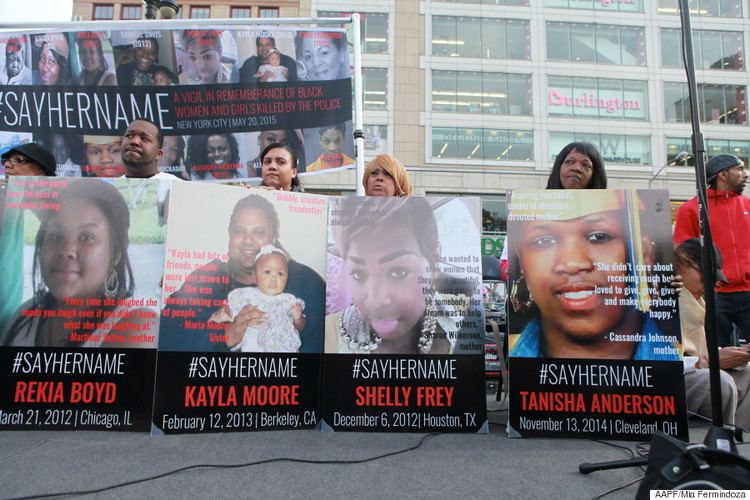
In May 2015, the AAPF released a report entitled "Say Her Name: Resisting Police Brutality against Black Women," which outlined the goals and objectives of the #SayHerName movement. Following Sandra Bland's fatal encounter with police in July 2015, the AAPF, in conjunction with the Center for Intersectionality and Social Policy Studies at Columbia Law School and Soros Justice Fellow, Andrea Ritchie, issued an updated version of the original report. The updated version includes a description of the circumstances surrounding Bland's death, as well as several accounts detailing recent incidents of police-instigated violence against black women, including Tanisha Anderson and Rekia Boyd. In addition to these accounts, the report provides an analytical framework for understanding black women's susceptibility to police brutality and state-sanctioned violence, as well as offers some suggestions on how to effectively mobilize various communities and empower them to advocate for racial justice.
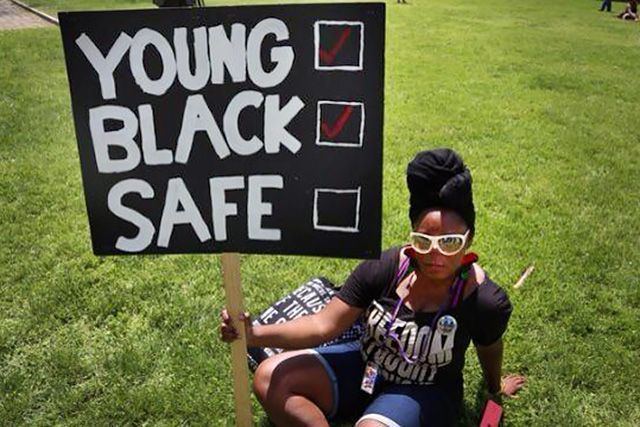
Drawing from the AAPF report, the #SayHerName movement strives to address the invisibilization of black women within mainstream media and, more specifically, the #BlackLivesMatter movement. Of the movement's many agendas, one includes commemorating the women who have lost their lives due to police brutality and anti-Black violence. To advance this agenda, the AAPF, along with twenty local sponsors and the Center for Intersectionality and Social Policy Studies at Columbia Law School, organized a vigil on May 20, 2015, in New York City, where dozens gathered to demand that the public no longer ignore black women's struggles against gendered, racialized violence.

Origins of the Movement

The #SayHerName movement arose as a result of the Black Lives Matter movement and the mainstream media's tendency to sideline the experiences of black women in the context of police brutality and anti-Black violence. In recent years, the killings of unarmed black men like Trayvon Martin and Michael Brown have captured much more national attention and public outrage than the killings of black women such as Rekia Boyd and Shelly Frey. According to Kimberlé Crenshaw, one of the founders of the AAPF, black women's continued exclusion from stories about police brutality, racism, and anti-Black violence contribute to an erroneous notion that black men are the chief victims of racism and state-sanctioned violence, and underplay issues such as rape and sexual assault by police. #SayHerName does not seek to replace Black Lives Matter or dilute its power, but simply add perspective and voices to the conversation of racial injustice.
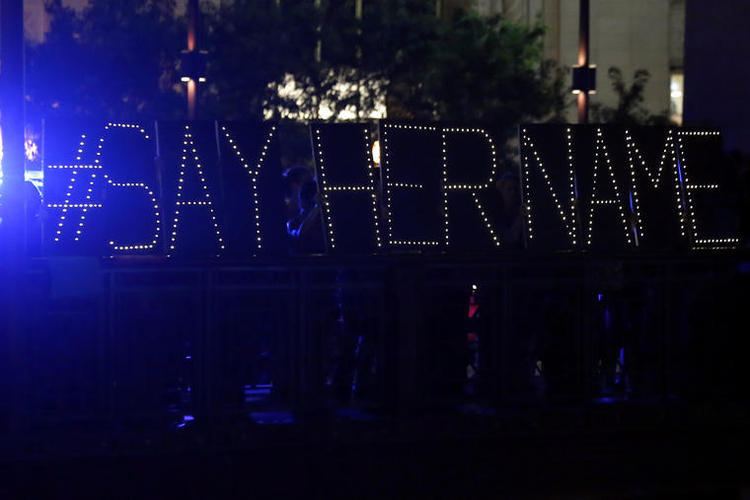
The movement actively considers how multiple social identities (including gender, sexual orientation, and class) influence an individual's experiences with police brutality and anti-Black violence, a concept known as intersectionality.
Intersectionality
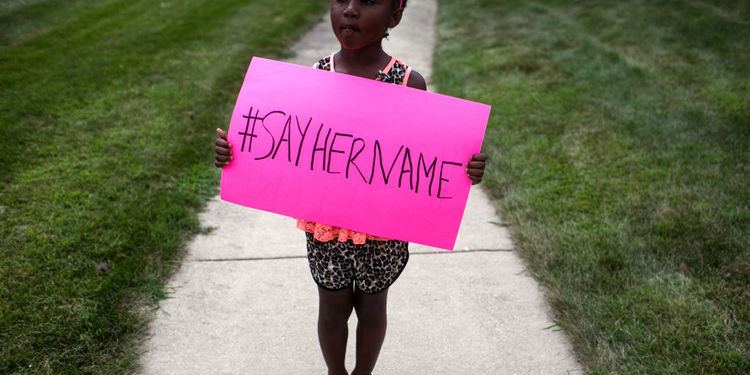
#SayHerName builds off of pre-existing texts and movements like the 2001 report Whose Safety? Women and the Violence of Law Enforcement – by Anannya Bhatacharjee – in order to expand on addressing systemic violence in a way that is committed to being intersectional. Works that have been published as results of intersectional approaches to victimization through violence include Beth Richie’s Arrested Justice: Black Women, Violence, and America’s Prison Nation (2012) as well as a list from INCITE! Including The Color of Violence: The INCITE! Anthology, Law Enforcement Violence Against Women of Color and Trans People of Color: A Critical Intersection of Gender and State Violence, and Queer (In)Justice: The Criminalization of LGBT People in the United States.
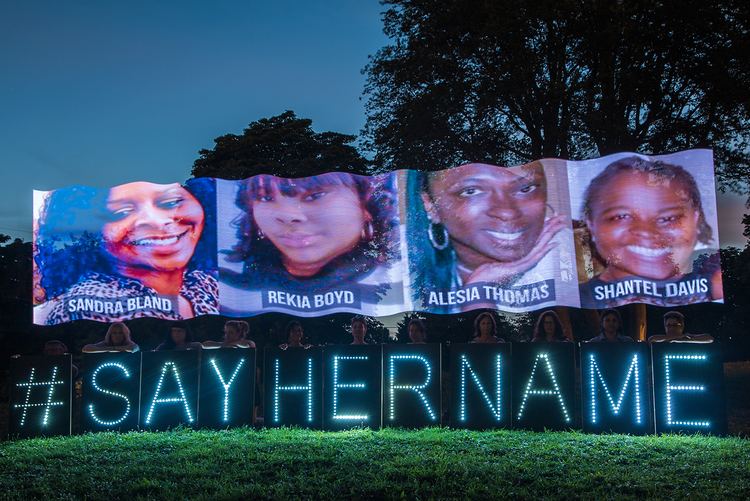
#SayHerName as a movement is largely based on the concept of intersectionality in order to bring attention to the full scope of victims of systemic violence. Intersectionality is a term that Kimberlé Crenshaw was responsible for coining, its earliest usage being dated to 1989. Since then it has become a key element of many modern feminist practices. Brittany Cooper explains how intersectionality provides an analytical frame originally designed to address the unique positions of women of color within rights movements. Its relevance to #SayHerName is highlighted by Crenshaw’s founding position in both the concept of ‘intersectionality’ and the movement itself. The focus on the victimization of black women within the #SayHerName movement is dependent on the notion of intersectionality, which Kimberlé Crenshaw describes as “like a lazy Susan – you can subject race, sexuality, transgender identity or class to a feminist critique through intersectionality.”

Additional factors in an intersectional analysis within #SayHerName include cis or trans status, education, geographical location, and disability – both on the parts of the victims being targeted and the officers responsible for the violence. Kimberlé Crenshaw especially highlights the role of both physical and mental disability as a factor that puts victims at a larger risk of being targeted as threatening or otherwise violent by police. This is exacerbated by stereotypes of aggressiveness and poor emotional control attributed to black women and men in the United States of America.
Homa Kahleeli asserts that over seventy black women have died as a result of either police violence or police misconduct within the past three years. In instances of police misconduct where firearms are discharged, both female and child victims of murder have been objectified with the label “collateral,” which diminishes the violence of murder and erases responsibility of the officer. #SayHerName highlights collateral treatment as a unique form of violence that these victims face in contrast with the black men addressed by the Black Lives Matter movement.
Andrea J. Ritchie argues that in addition to/included within this group of seventy black women is a larger category of people who have been targeted by police violence that #SayHerName addresses. This category includes the high rates of queer and transgender women of color who have been disproportionately targeted. These disparities emerge from gendered norms and stereotypes with roots in slavery and colonialism that have been further contextualized through the war on drugs and the legal debates surrounding LGBTQ rights.
Social Media
The #SayHerName movement is one of many contemporary social justice campaigns that engage in hashtag activism and digital activism. Coined by the AAPF in February 2015, the #SayHerName hashtag provides an online community for activists, scholars, news reporters, and other social media users to participate in the conversation on racial justice along with other social movements such as #BlackLivesMatter.
The hashtag is mostly active on Twitter. Of its many uses, the #SayHerName hashtag has principally served to highlight recent incidents of black women's fatal encounters with police and anti-Black violence as well as advertise upcoming events.
By addressing recent incidents of police-instigated violence, the #SayHerName hashtag strives to advance one of the chief goals of the movement: to re-integrate black women's lived experiences into mainstream racial justice narratives about police brutality and state-sanctioned violence. Through its engagement with hashtag activism, #SayHerName situates itself within a recent social historical development in which the media's tendency to disregard or heavily misrepresent events pertaining to racial justice incites activists to commit themselves to digital activism. In addition, with its increasing social media presence, #SayHerName provides an opportunity for a diversity of voices invested in racial justice to contribute to an ever-expanding discourse on black women's susceptibility to police brutality and anti-Black violence.
Supporters
Some of the strongest original supporters of the #SayHerName movement include people who were directly impacted by the killings. Friends, family members, and individuals who shared similar social identities with the victims were and remain likely to participate in mobilization efforts. Mothers especially appear to have a strong emotional connection to the cause and are willing to speak out against police brutality and anti-Black violence. Given the accessibility of technology and today's 24-hour news cycle, many young people, (namely, those aged 18-34 years old) are often motivated to engage with one another and protest acts of racial injustice online.
The movement has received support from several celebrities, which is integral to the spread of the movement and its social media reach. Through the use of the #SayHerName hashtag, influential figures can increase public awareness and shed light on instances of racial injustice, which can sometimes go unnoticed. Such high-profile support was seen immediately following the death of Sandra Bland: musical artist Janelle Monae tweeted the #SayHerName hashtag, as did actress Taraji P. Henson. Nicki Minaj, Jessie J, and Zendaya Coleman all recognized Bland's death on Instagram. This kind of support further signifies the importance of intersectionality for both the movement generally as well as its supporters.
The American Civil Liberties Union has supported the movement, using the hashtag to promote activism particularly regarding violence against transgender women of color. The Human Rights Campaign likewise uses the hashtag in this manner. The 2017 Women's March also used the hashtag on their Twitter in recognizing transgender women of color killed in 2017.
Action
Since the movement began in early 2015, there have been two nationwide events (one that occurred in May of that year and another one twelve months later) to increase public awareness. The second #SayHerName Silent Protest: National Day of Action to End State Violence Against Women and Girls took place in major cities around the country and garnered significant attention on social media. In New York, Chicago, Los Angeles, and elsewhere, men and women took to the streets with duct tape over their mouths to represent the silence and erasure of black women and girls' narratives along with signs in their hands to remember those that have lost their lives to police brutality and anti-Black violence.
Criticism
Advocates claim that the #SayHerName hashtag has successfully created a safe online place for marginalized groups of all areas of life to come together and mourn their losses. But as the hashtag spreads from Twitter to Facebook and other social media platforms, the rhetoric does not change. Despite the diversity in background, with each woman sharing her story, the same underlying themes of vulnerability to physical police and aggressive sexual violence keep reappearing, making it appear that simply saying the names, remembering the faces and increasing awareness is not enough. Experts say that despite being only 7% of the population and outnumbered by white women at the ratio of 5:1, black women and girls have accounted for 20% of the unarmed people killed by police since 1999. In other words, while the hashtag was able to bring awareness on a global platform and make a safe space to spark interest and conversation between different people, statistics are not showing a real change in the level of threat and violence towards women of color.
Relationship with #BlackLivesMatter
Although the movement makes an active effort to engage in discourse and conversation with the Black Lives Matter movement, #SayHerName is different in its construct, goals and methods. Feminist theorists such as Kimberle Crenshaw have pointed out that the #SayHerName movement addresses intersectionality of gender, class and disability that play out on black women and girls’ bodies. These are aspects that do not appear to be so readily addressed by the Black Lives Matter movement, which is specifically known as a movement addressing racial inequality within the criminal justice system. Many supporters for the Black Lives Matter movement were largely sparked by outrage of the deaths of young, African-American males at the hands of police with excessive violence and no repercussion from the legal system. In contrast, when stories of African-American women meeting similar fates in just as harrowing circumstances were brought up, the amount of supporters and advocates seemed to decrease; female victim’s names and stories are generally less recognized than the male victims. #SayHerName aims to raise awareness of how sexism and racism simultaneously play out of colored female bodies, no matter their background, while still being a safe, inclusive space for all individuals to come together and create discourse.
African American Policy Forum's Role
The #SayHerName movement represents one of three recent racial justice initiatives engendered by the AAPF. Since coining the #SayHerName hashtag in February 2015, the AAPF has assumed a central role in mobilizing the campaign – an effort which has culminated into at least two significant events: the AAPF's release of the report "Say Her Name: Resisting Police Brutality against Black Women" and its sponsoring of "#SayHerName: A Vigil in Remembrance of Black Women and Girls Killed by the Police." Both events occurred in May 2015 and have served to disrupt mainstream racial justice narratives that attend exclusively to heterosexual, cisgender black men's susceptibility to police brutality and anti-Black violence.
May 2015 report
In May 2015, the AAPF, in conjunction with the Center for Intersectionality and Social Policy Studies at Columbia Law School and Soros Justice Fellow, Andrea Ritchie, issued a report entitled "Say Her Name: Resisting Police Brutality against Black Women." The report highlights the goals and objectives of the #SayHerName movement and presents several reasons as to why gender-inclusivity is a critical component of racial justice advocacy. In addition to these, the report includes several accounts detailing incidents from the last three decades of black women's fatal encounters with police brutality and state-sanctioned violence. To supplement these accounts, the report incorporates an intersectional framework for understanding black women's susceptibility to police brutality by addressing how the interactions between race, gender, sexual orientation, class, and ability inform the violent ways in which law enforcement officials treat black women.
After divulging recent incidents of police brutality against black women, the report concludes with several recommendations as to how members of local communities, policy-makers, researchers, and activists can best incorporate a gender-inclusive framework into racial justice campaigns that specifically address police brutality and state-sanctioned violence. By contributing these recommendations, the AAPF, along with the Center for Intersectionality and Social Policy Studies at Columbia Law School and Andrea Ritchie, hopes that the report could serve as a useful resource to which the media, community organizers, policy-makers, and other stakeholders invested in racial justice can refer.
After Sandra Bland's fatal encounter with police in July 2015, the AAPF released an updated version of the original report. While the structure of the updated version is similar to that of the original report, the updated version contributes additional accounts of black women's deadly encounters with police and includes a description of the circumstances surrounding Bland's death. By issuing the updated version, the AAPF strives to reinforce the critical, urgent need for policy-makers, the media, community organizers, and other stakeholders to tackle the structural inequalities that render black women within the United States heavily susceptible to police-instigated, anti-Black violence.
Recommendations
Since the ultimate goal of #SayHerName is to raise awareness for black female victims of police brutality and anti-Black violence in the United States, the AAPF has published a "Take Action Guide," specific to the movement, that lists five action items/policy recommendations. These policy recommendations can be implemented immediately, and they include: "find ways to support all families who have lost loved ones to police violence, create spaces to discuss how the intersections of patriarchy, homophobia, and transphobia impact Black communities as a whole, and continuously develop skills to talk about the multiplicity of ways in which state violence affects all Black women and girls, particularly those who are transgender, non-transgender and gender-nonconforming."
Events
The AAPF hosts events promoting the #SayHerName movement on a semi-regular basis. One example is an event taking place in March 2017 entitled "Say Her Name: An Evening of Arts and Action Los Angeles."
Spread of the movement
In the evening of May 20, 2015, the AAPF, along with twenty local sponsors, including the Black Youth Project 100, and the Center for Intersectionality and Social Policy Studies at Columbia Law School, organized an event called "#SayHerName: A Vigil in Remembrance of Black Women and Girls Killed by the Police." The purpose of the vigil, which transpired at Union Square in New York City, was to commemorate such women as Rekia Boyd, Tanisha Anderson, Miriam Carey, and Kayla Moore, among many others, who lost their lives due to police brutality and anti-Black violence. Of the vigil's many attendants, several included the relatives of Tanisha Anderson, Rekia Boyd, Shantel Davis, Shelly Fray, Alberta Spruill, Kyam Livingston, Kayla Moore, Miriam Carey, and Michelle Cusseaux. The vigil marks the first time that these family members gathered at the same location for the purpose of honoring the women who died as a result of police-instigated violence.
In addition to commemorating the lives of such women as Shelly Fray and Kyam Livingston, the event featured speeches, singing, poetry, and art by scholars, artists, and activists, including Kimberlé Crenshaw, Piper Anderson, Eve Ensler, LaChanze, and Aja Monet. Given how the vigil occurred one day prior to the National Day of Action on Black Women and Girls, one of its principal aims was to mobilize the New York City community into action against gendered, racialized forms of violence and police brutality. By demanding that the public no longer ignore black women's struggles against gendered, racialized violence, the vigil's attendants strove to advance one of the chief goals of the #SayHerName movement: to re-integrate black women leaders and victims of anti-Black violence into mainstream racial justice narratives about racism and police brutality.
On the other side of the country in May 2015, black women and girls also stood in the middle of San Francisco, holding signs and displaying painted messages on their bare chests. Some phrases included “I fight for those who have been murdered by the state”, “with love for female masculinity” and “to end infant mortality”. These women embodied a number of identities, some of which included queer and transgender individuals, all joining together to recognize state-sanctioned violence and sexual assaults targeting women of color. Onlookers were said to connect with the emotional stories protesters shared that day through conversation and the vulnerability of being naked, both in the moment and on a political level. Similar to how historically black women were lynched and subject to physical abuse like black men, today, black women are raped, brutalized and killed by the police, vulnerable to violence and not empathized with or helped.
